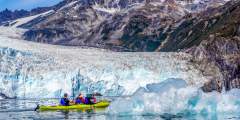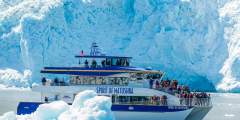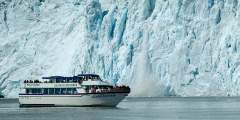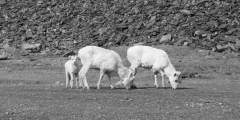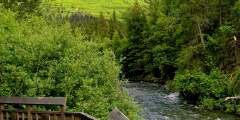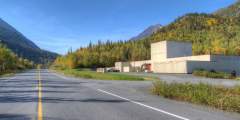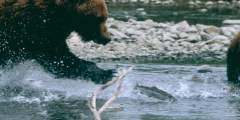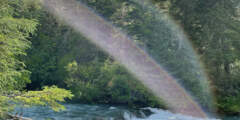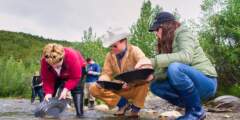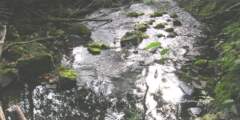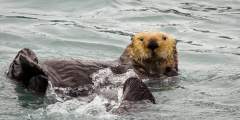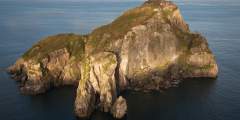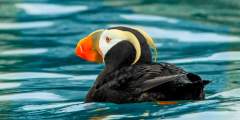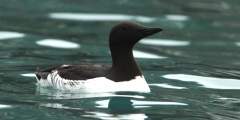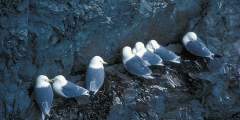The Best Wildlife Viewing Spots in Seward
Every summer visitors flock to Seward to see whales, sea otters, and more in Kenai Fjords National Park. Day cruises are the best way to see marine wildlife and tours of varying lengths are available all summer long.
Day cruises also offer great shorebird viewing opportunities so be on the lookout for puffins, cormorants and kittiwakes. While onboard your attention may be directed to the shoreline to look for mountain goats high on the cliffs or bald eagles perched in the trees as well.
The first listing below describes the highlights of what you might see during a Kenai Fjords boat tour, including where to look for different species.
Other wildlife opportunities in Seward include sightings from area hiking trails where you may spot a moose or a black bear.
Show Map
Best Wildlife Viewing Spots in Seward
Seward Day Cruises
Get up close to the Alaskan glaciers and wildlife you came to experience by taking a cruise into Kenai Fjords National Park on a custom-built catamaran out of Seward. The difference from other cruises, is that you’ll then get off the boat and into a kayak, paddle around icebergs, and watch for wildlife from your own vessel.
Resurrection Bay and Kenai Fjords are great places to see wildlife and glaciers. And Major Marine’s vessels, which have cozy heated cabins and an outdoor viewing area, can take you out to see both. This family-owned tour operator has gone above and beyond to give guests an amazing day on the water since 1990.
This veteran tour operator runs a a fleet of fast, modern boats in Resurrection Bay and Kenai Fjords National Park. You’ll visit tidewater glaciers as you watch for puffins, sea otters, Dall’s porpoises, sea lions, and more. Some tours are designed to please birders or shutterbugs, while others are perfect for families.
Eagle Viewing Spots
At the Seward Small Boat Harbor look out at the rock jetties and buoys. Eagles like to sit on these spots and monitor their domain. Food is also plentiful from fisherman cleaning fish, seabirds that stay in the area and fish that return to the streams nearby.
Sheep & Mt. Goat Viewing Spots
The western coast of outer Resurrection Bay near Seward offers the state’s best opportunity to see wild goats up close, with animals often perched on ledges just above the sea — making the area a popular destination during marine wildlife cruises out of Seward.
Salmon Viewing Spots
This salmon viewing location includes an all-acccessible viewing platform overlooking the creek as well as viewing opportunties along Ptarmigan Creek trail. Sockeye salmon will be in the creek from late July to early October with the best viewing in mid-August. Vehicle parking is in the day use area inside Ptarmigan Creek Campground.
Learn how the fish are raised from small alevin to fry and beyond to smolt size before being released into surrounding lakes and bays. Depending on the fish cycle, there may or may not be fish to view, so please call ahead. If there are no fish to be seen, you’re welcome to look at a small photo gallery and learn about the fish production cycle, and understand why hatchery’s play such an important role in keeping our fish population… ...more
The salmon lifecycle and a working salmon-counting operation is on the menu here, as well as a fresh salmon for your dinner, if you time your visit just right. Hear how!
Great sockeye salmon observation site, especially in late July and early August. At other times of year it offers a moderate walk up to Ptarmigan Lake that’s great for families and features lots of bird life.
From the gravel pullout on the west side of the highway, an easy 1⁄4 mile walk to the Sockeye salmon viewing platform awaits (not fully accessible). Salmon are in the creek from mid-July to early August with the best viewing in late July.
Grouse Creek runs adjacent to the Seward Highway. To access this creek, exit onto the paved pullout at mile 8.3. There’s a Chugach National Forest sign here too that marks the spot. From late- July to mid-September, you will be able to view sockeye salmon with the best chance of seeing fish in mid-August.
Birding Viewing Spots
Just south of Seward you could spot humpback whales, sea lions, bird life and old growth forest habitat. There’s a great sand beach at the end that will reward your exploration, so let’s go!
As the boat pulls away from the nesting areas of the horned puffins it will turn left and again stay right next to the cliff face. You’ll notice some pelagic and possibly red-faced cormorants nesting high on the cliff just after the boat turns to the left for the final stretch of Cape Resurrection.
Here is the local favorite area of our Horned and Tufted puffins. You can tell the two species apart if you remember that “Tough Guys Wear Black.” The tufted puffin’s body is entirely black with distinctive long yellow “tufts” of feathers on either side of their head. Horned puffins have a white belly and black back. These puffins come to land only to lay their eggs and raise their young. Puffins spend most of their lives about 400 miles away… ...more
Some of the little caves on the tip of the cape contain nesting Common murres. You may also be seeing many of these murres on the water. They have black heads, black backs and white bellies. They are Alcids, like the puffins, so they are diving birds that use their wings for propulsion under water. Of all the alcids, common murres can dive the deepest, plunging to record depths of at least 600 feet.In addition to the cave nesters on the Cape,… ...more
Up ahead the noise and odor of the Black legged Kittiwakes will soon become apparent. These birds take advantage of the slight depressions in the rocks to build their nests. Their nest is simply some grass and mud glued to the rock wall with their own guano. These birds nest in dense aggregations as a means of protection against birds of prey.If a Bald eagle or Peregrine falcon flies into the area every bird will leave the rocks in one… ...more
Just up ahead on the right is a small rock that sticks above the water and almost always has a mixed group of cormorants standing atop it drying out their feathers. This long necked black bird dives in the water and uses its feet to swim but unlike the puffins and other alcids has no oil in its feathers to aid in drying off. So they stand out on rocks to get dry.Just up ahead on the left you will see a rock with many gulls on top of it and… ...more

